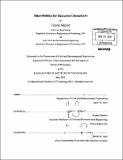| dc.contributor.advisor | Roman Stocker. | en_US |
| dc.contributor.author | Ahmed, Tanvir, Ph. D. Massachusetts Institute of Technology | en_US |
| dc.contributor.other | Massachusetts Institute of Technology. Dept. of Civil and Environmental Engineering. | en_US |
| dc.date.accessioned | 2011-11-01T19:52:42Z | |
| dc.date.available | 2011-11-01T19:52:42Z | |
| dc.date.copyright | 2011 | en_US |
| dc.date.issued | 2011 | en_US |
| dc.identifier.uri | http://hdl.handle.net/1721.1/66851 | |
| dc.description | Thesis (Ph. D.)--Massachusetts Institute of Technology, Dept. of Civil and Environmental Engineering, 2011. | en_US |
| dc.description | Cataloged from PDF version of thesis. | en_US |
| dc.description | Includes bibliographical references (p. 136-151). | en_US |
| dc.description.abstract | Bacterial chemotaxis, a remarkable behavioral trait which allows bacteria to sense and respond to chemical gradients in the environment, has implications in a broad range of fields including but not limited to disease pathogenesis, in-situ bioremediation and marine biogeochemistry. And therefore, studying bacterial chemotaxis is of significant importance to scientists and engineers alike. Microfluidics has revolutionized the way we study the motile behavior of cells by enabling observations at high spatial and temporal resolution in carefully controlled microenvironments. This thesis aims to explore the potential of microfluidic technology in studying bacterial behavior by investigating different aspects of bacterial chemotaxis on a microfluidic platform. We quantified population-scale transport parameters of bacteria using videomicroscopy and cell tracking in controlled chemoattractant gradients. Previously, transport parameters have been derived theoretically from single-cell swimming behavior using probabilistic models, but the mechanistic foundations of this up-scaling process have not been proven experimentally. The parameter estimates computed directly from single-cell swimming information showed good agreement with literature values providing the experimental verification of the upscaling from single cells to population-scale models. Furthermore, we also developed a diffusion-based microfluidic device to generate steady, arbitrarily shaped chemical gradients. Steady gradients, linear or nonlinear, are often a useful model of the bacterial microenvironment to study chemotaxis in the limit of slow patch diffusion or fast motility of free swimming bacterial cells. Observed cell distribution along the gradients showed good agreement with predictions from the bacterial transport equation, providing the first quantification of chemotaxis in steady nonlinear gradients. Also, by observing the time series of the bacterial distributions in different scaled gradients (both steady and unsteady) generated using microfluidic devices, the bacterial response was found to be invariant up to an 87-fold change in ambient chemoattractant concentration. These observations provide an explanation for the ability of bacteria to cope with a broad range of chemical concentrations and gradients in the environment, by means of a flexible sensing network that allows them to rescale their response to take maximum advantage of signals, while discounting less-informative background information. Finally, a microfluidic lattice habitat was developed to study the fate of a chemotactic bacterial population under the pressure of predation. It was observed that the demographic and spatial organization of the bacterial prey population depended on the predator-to-prey ratio as well as on the degree of heterogeneity of the habitat structure. These results represent a first step towards predator-prey microcosms and pave the way for future predator-prey metapopulation studies. | en_US |
| dc.description.statementofresponsibility | by Tanvir Ahmed. | en_US |
| dc.format.extent | 151 p. | en_US |
| dc.language.iso | eng | en_US |
| dc.publisher | Massachusetts Institute of Technology | en_US |
| dc.rights | M.I.T. theses are protected by
copyright. They may be viewed from this source for any purpose, but
reproduction or distribution in any format is prohibited without written
permission. See provided URL for inquiries about permission. | en_US |
| dc.rights.uri | http://dspace.mit.edu/handle/1721.1/7582 | en_US |
| dc.subject | Civil and Environmental Engineering. | en_US |
| dc.title | Microfluidics for bacterial chemotaxis | en_US |
| dc.type | Thesis | en_US |
| dc.description.degree | Ph.D. | en_US |
| dc.contributor.department | Massachusetts Institute of Technology. Department of Civil and Environmental Engineering | |
| dc.identifier.oclc | 757995923 | en_US |
